
10 Facts about Arch (+ Tented Arch) Fingerprints!

MARCH 9, 2015
10 Facts about Arch Fingerprints!
In the perspective of fingerprints the term 'arch' refers to the presence of an arch-like shape; the 2nd key-characteristic of this fingerprint type is the missing of a triradius - though this characteristic is only present in the sub-category 'plain arches', because in the less common sub-category 'tented arches' a triradius is usually present.
Arches (and tented arches) are most likely found on the index finger: international studies indicate that percentages close to 15% are typical. But they are also relatively often seen on the middle finger up to almost 10%, and/or the thumb up to above 5%. Beyond the index finger, arches are in most fingers usually more than 3x more common than radial loops.
In the fields of hand reading arches tend to get associated with a 'simple type of personality' - refering to the fact that the arch represent the most simple fingerprint type (because technically there is no 'true pattern' present in arches).
Until 2015 there is no confirmed evidence available that substantiates this assumed 'belief'.
What are the facts?
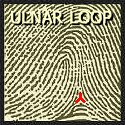
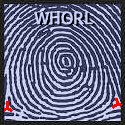
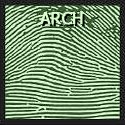
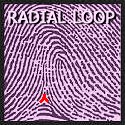
ULNAR LOOP [UL] - WHORL [W] - ARCH [A] - RADIAL LOOP [RL]
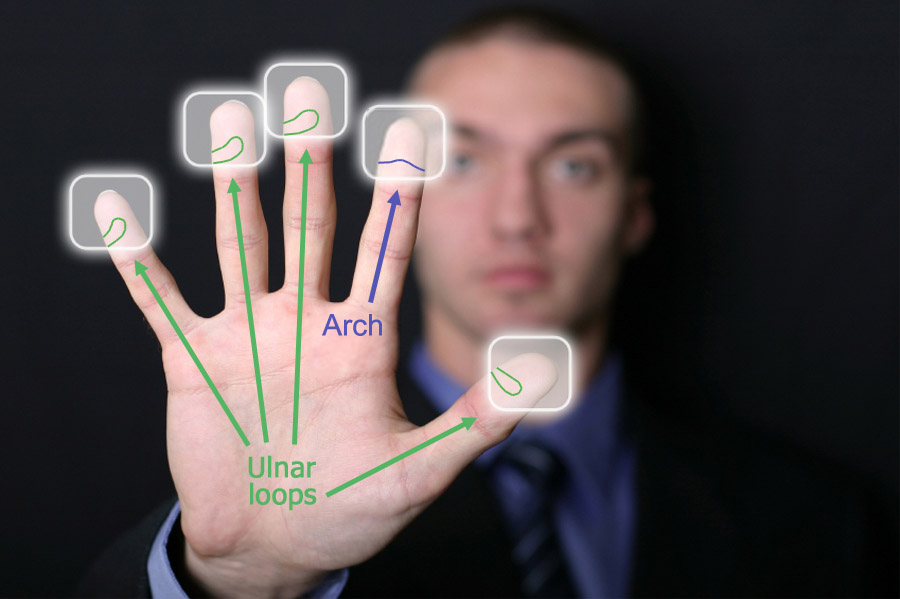
• ARCH FACT 1: Arches represent the 3rd most common category
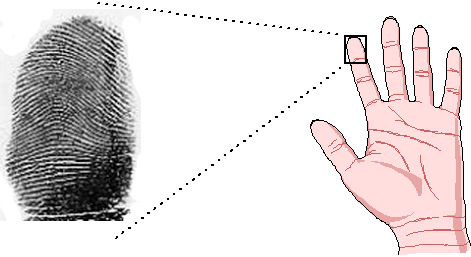
In most regions around the world is the arch (international avg: 6.0%), after the ulnar loop (50.0%) & whorl (41.0%), the 3rd most common major category; radial loops (3%) represent the 4th major category - percentages taken from the article:
The Fingerprints World Map.
In nearly all regions around the world is the arch by far most commonly found on the index finger, usually about 35% of all arches are found on the index finger.
Regarding the other 4 digits (beyond the index finger), arches are most likely observed in respective: the middle finger & thumb, and arches are least common in both the ring finger & pinky finger. It appears that especially in both white- and black populations the single-hand combination (thumb to pinky)
UL-A-UL-UL-UL belongs to the 14 most common combinations (where UL-UL-UL-UL-UL represents usually the most common combination).
The 11 most common fingerprints combinations with at least one arch on any finger (8 out of 11 include an arch on the index finger) are listed according estimated order of prevalence below:
I - II - III - IV - V (= thumb to pinky finger)
UL-A-UL-UL-UL
UL-A-A-UL-UL
UL-RL-A-UL-UL
A-UL-UL-UL-UL
A-A-A-A-A
A-A-UL-UL-UL
UL-UL-A-UL-UL
UL-A-A-A-UL
A-A-A-A-UL
W-A-UL-UL-UL
W-A-UL-W-UL
NOTICE: A = arch, UL = ulnar loop, RL = radial loop, W = whorl.
In general, arches are less common in especially Asia & most indigenous Australian populations.
Indicative percentages (derived from 30 international populations around the world) for the presence of arches on the individual fingers in the general population are: 3.3% for the thumb, 10.3% for the index finger, 4.4% for the middle finger, 2.5% for the ring finger, and 2.0% for the pinky finger.
The picture below provides an overview of the distribution for the 4 major fingerprint types among male- and female populations from in respective: the US, UK, China, Iran & Nigeria.
NOTICE: In primates the distribution of arches is very different compared to man; Cummins & Mildo (1943) report:
"In chimpanzee the frequencies are, in rounded number: whorls, 50%; ulnar loops, 40%; radial loops, 9%; arches, 2%. ... Arches occur chiefly on finger V instead of on fingers II and III in man.".
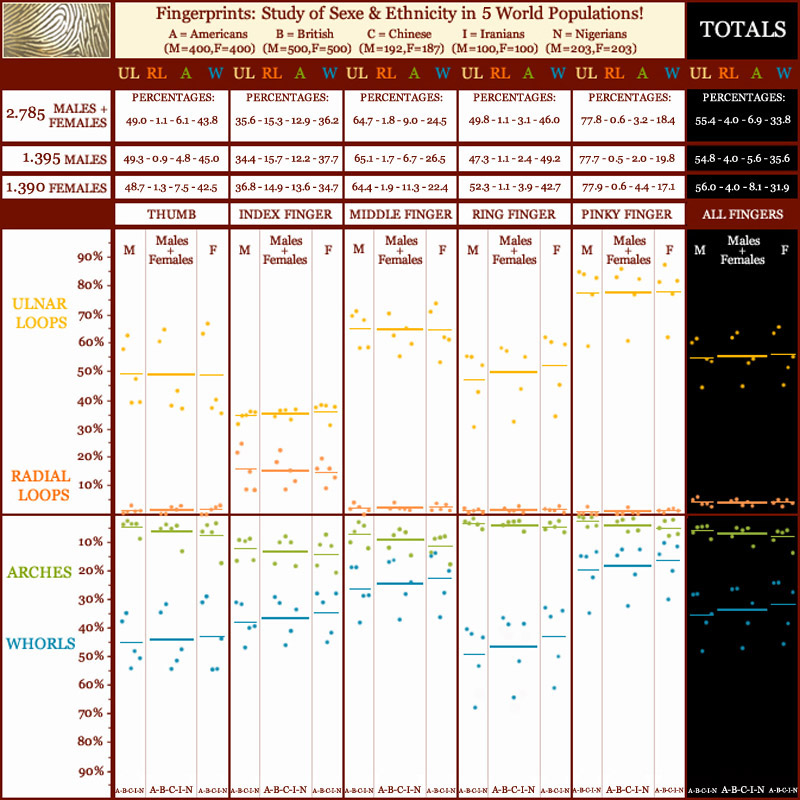
Fingerprint pattern configurations correlate with the location-, shape- and size of the so-called prenatal volar pads (= swelling of mesenchymal tissue in the 3rd month of pregnancy). And skin ridges are understood to become manifest in the surface of the skin due to tension & pressure forces in upper layer of the skin.
Volar pads typically tend to manifest as intermediate pads with a location slightly shifted towards the radial (thumb) side of the hand - which represent the typical features that get associated with the most common major category: ulnar loops. However, when the size of the volar pad is small and featured without any significant tilting this typically represent the preceeding stage in the development of an arch fingerprint.
The major principles describing the correlation between early prenatal volar pad development & fingerprint pattern configurations is described in the picture below (according Kuecken, 2004); higher symmetric pads tend to develop into whorls, and lower symmetric pads tend develop into arches.
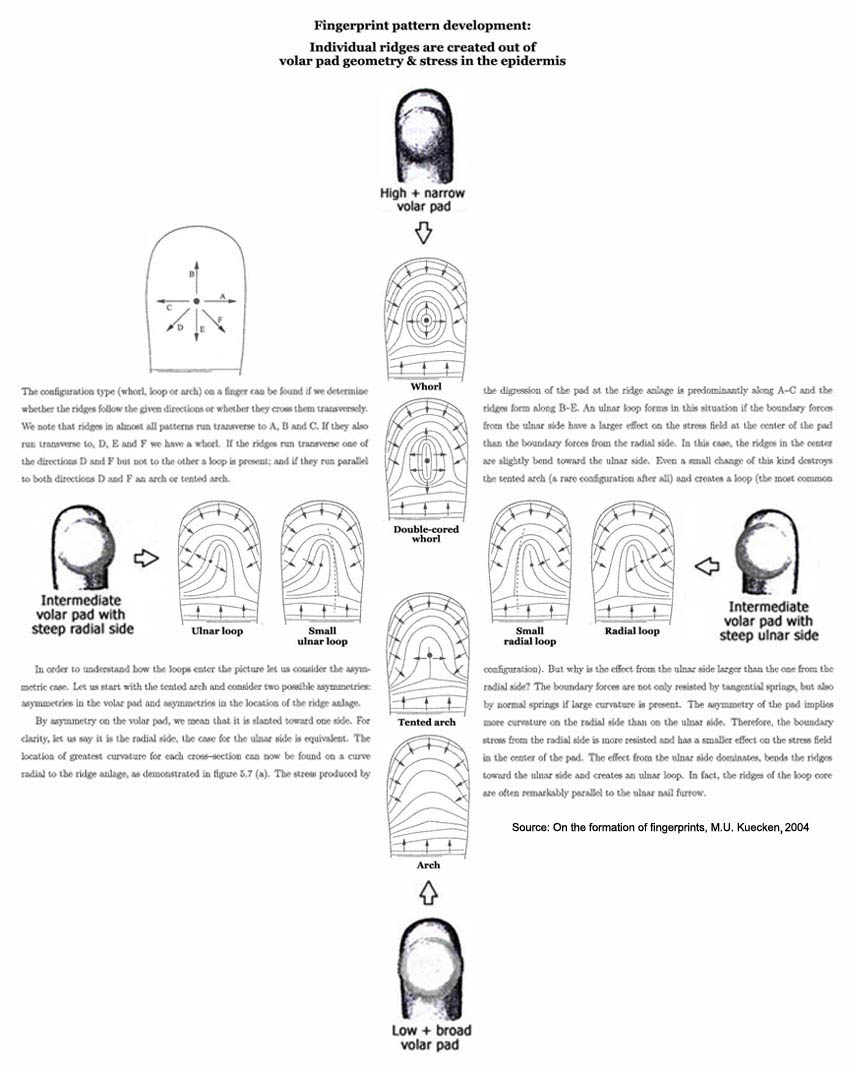
Fingerprint statistics around the world point out that the prevalence of arches varies significantly from country to country. However, arches are especially more common in Africa, North-Europe & the West-Caribean area; arches are less common in East Asia + the pacific islands near Australia.
Combining the statistics in the map below + the data features inside the fingerprint world map, the result shows that there is one region in the world that has been known for quite a while to have the highest percentages of arches around the world: the South-West of the continent Africa - NOTICE: In this African region arches are known to have a peak of prevalence in Efé pygmies (their residence is in the Democratic Republic of the Congo) and Bushmen (their residence is in various South African countries, including: Botswana, Namibia & South-Africa).
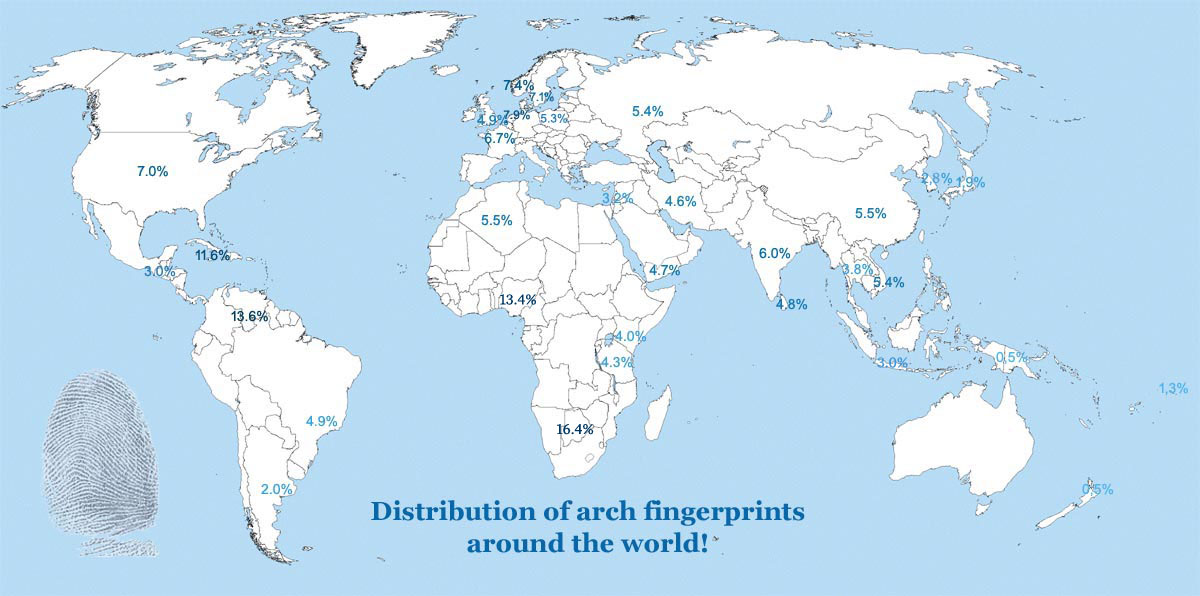
 Fingerprint statistics around the world point out that the prevalence of arches also varies between the two sexes; these are the typical patterns (see for example: Cummins & Midlo in 'Finger prints, Palms & Soles'; 1943, p.273):
Fingerprint statistics around the world point out that the prevalence of arches also varies between the two sexes; these are the typical patterns (see for example: Cummins & Midlo in 'Finger prints, Palms & Soles'; 1943, p.273):
- Arches are usually more common in females (confirmed in 14 out of 16 populations displayed inside the table below).
- Ulnar loops are usually more common in females.
- Whorls are typically more common in males.
Just like whorls, radial loop fingerprints also typically have a higher prevalence in males; however it is important to be aware that this tendency is only likely to manifest when at least one of the other three patterns (listed above) is also present.
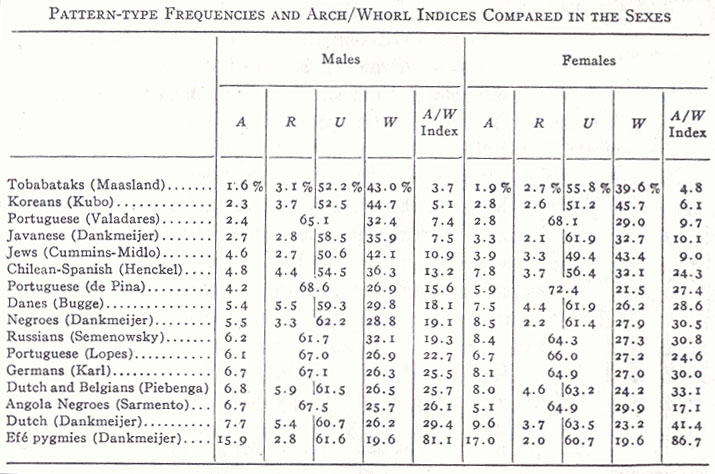
In the general population arches typically show a uniform distribution featured with a peak on the index finger (followed by a considerable percentage on the middle finger). However, in genetic disorders the distribution often changes dramatically.
For example, in Down syndrome (trisomy 21) the distribution becomes shifted towards a peak at the thumb (and most likely followed by a clearly lower percentage for the index finger) - see picture below.
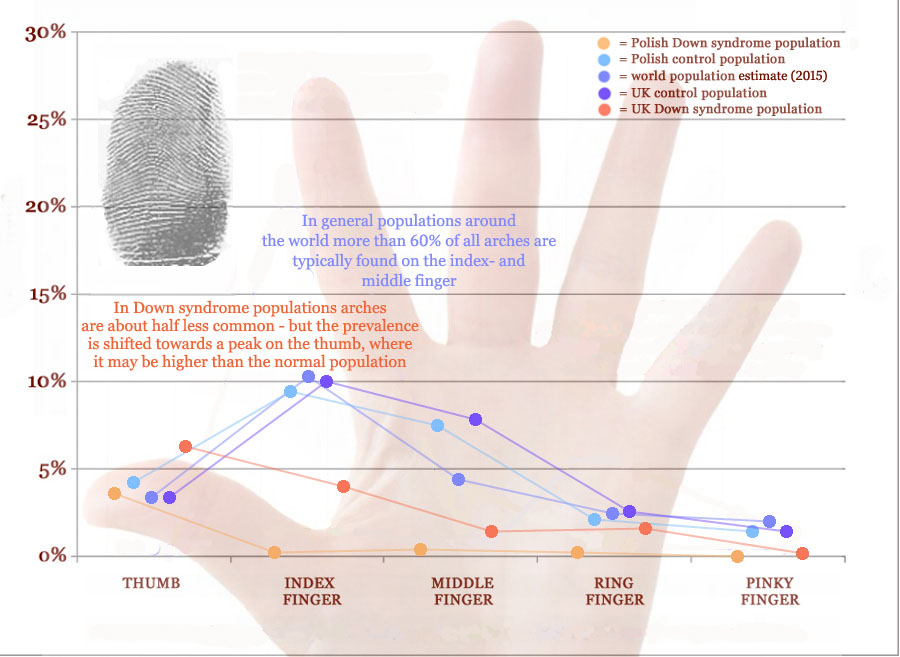
Studies beyond Down syndrome have as well indicates that actually many (inborn) chromosomal disorders also tend to display a different distribution of arches across the five fingertips; the sharp peak at the index finger is missing in the following syndromes:
- Trisomy 18 (Edward syndrome): arches are by far the most common pattern (about 90%), very often on all five fingers;
- Trisomy 13 (Patau syndrome): arches are common (about 20%), especially on the thumb, index- and middle finger;
- Trisomy 8: arches are most common (about 45%); - Fragile-X syndrome (Martin-Bell syndrome): arches are very common with atypical distributed peaks for the pinky and ring finger;
- Cri-Du-Chat syndrome: atypical distributed arches with a peak for the ring finger;
- Klinefelter syndrome: arches are more common with a peak for the thumb;
- Rubinstein-Taybi syndrome: arches are very common with atypical distributed peaks for the index finger and pinky;
- Wolf-Hirschhorn syndrome: arches are very common (with sort of a normal distribution);
- X-linked mental retardation: excessive fingerprint arches.
An excess of arches or an abnormal distribution of arches has so far been associated repeatedly with only a very small number of diseases, but usually the results of the studies involved were contradicted by other studies.
Higher percentages and abnormal distributions of 'arches' has been reported for Rheumatoid Arthritis (special attention for the 3rd digit), and higher tented arches in heart disease (coronary artery disease & myocardial infarction).
Inside a Dutch population [N=48] arch fingerprints turn out to be more common among introverts (= low scorers on the Big Five dimension Extraversion) than among extraverts (= high scorers on the Big Five dimension Extraversion) - see picture below. The distribution of arches in introverts appears shifted slightly towards the ulnar fingers, while in extraverts the radial loops appear shifted slightly towards the index finger and thumb.
Arches on the pinky finger were only present in 4 out of the 21 introverts (19.0%) - all four individuals also have arches on the index-, middle- and ring finger in at least hand. Among the 28 extraverts two individuals have arches in at least one hand present in the thumb only, or the combination of the thumb + index finger only (this combination was not seen in the introverts!).
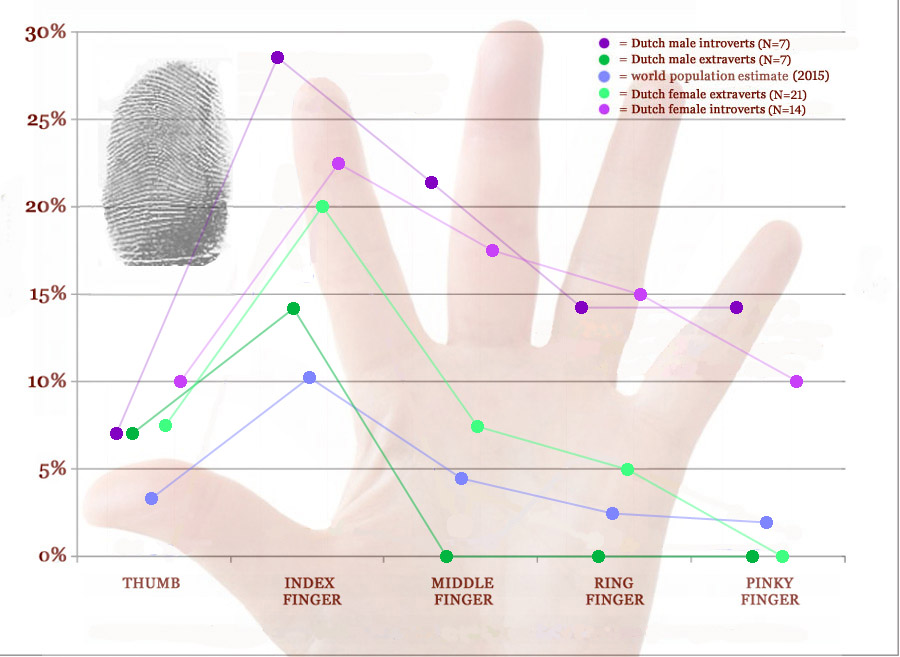
Inside a Dutch population arch fingerprints [N=75] turn out to be more common among emotional stable people (= low scorers on the Big Five dimension Neuroticism) than among neurotics (= high scorers on the Big Five dimension Neuroticism); this tendency is observed in all five fingers - see picture below.
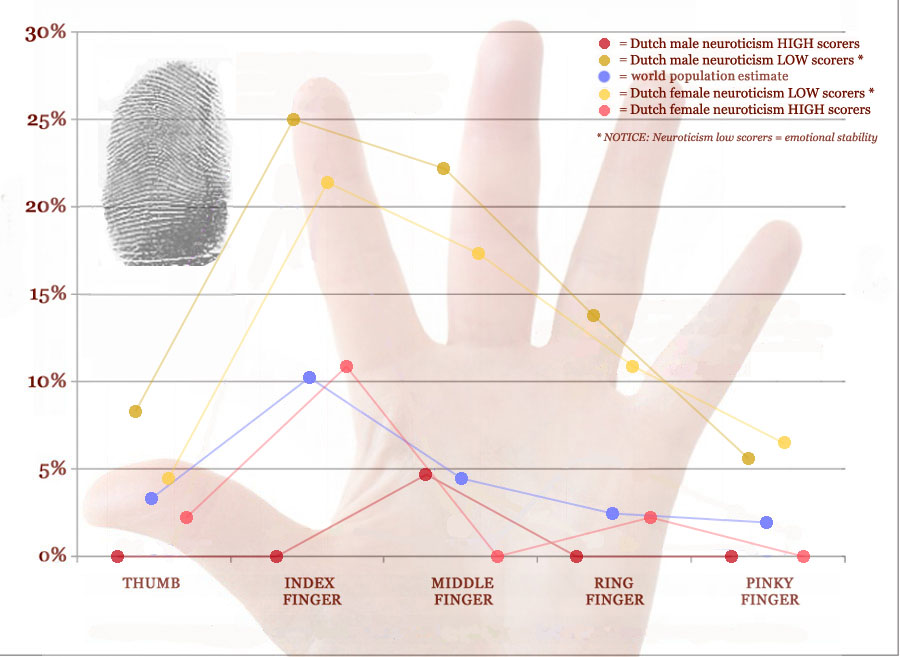
Distribution charts for the arch fingerprint will later become avaiable here for high- and low scorers on the other Big Five factors: Openess (originality), Altruism (accommodation) & Conscientiousness (consolidation).
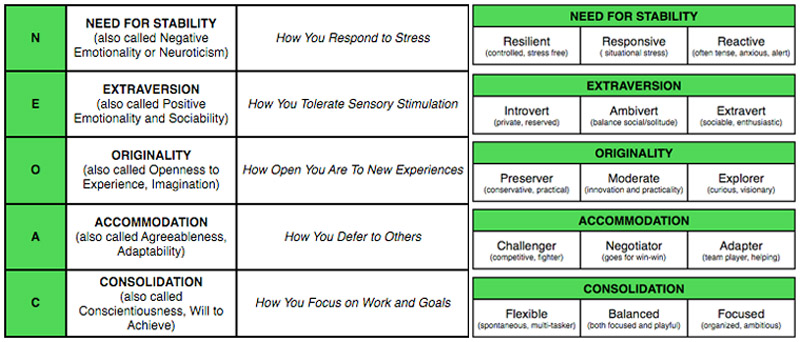

Inside the FBI system for fingerprint pattern type classification only two arch-related varations are used
(arches & tented arches); a more advanced approach involving five arch-related variations is presented
above; the significance of these advanced variations is described in the article Fingerprints & Behavior.
Whorls, peacocks & double loops always also include a 'radial' or 'ulnar' characteristic; but usually those aspects are being ignored in those patterns. A consideration of the volar pad features in those patterns explains why this choice can be justified; because for example the variations between an ulnar whorl and a radial whorl likely reflect a relatively small difference in the location of the typical central position of the volar pad (see also above: 'arch fact 3').
Likewisely, in the perspective of the volar pads one can also understand that the difference between an arch and a small loop reflects a relatively small difference in terms of the featured characteristics in the volar pads; because an arch represents typically a low broad volar pad positioned at the central axis, while a small loop most likely represents a volar pad that has slightly shifted away from the central axis.
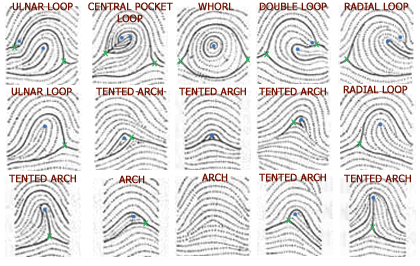 However, the volar pad difference between a large radial loop and a large ulnar loop can be recognized to represent a huge difference in terms of the volar pad location.
This suggests that a radial loop can be recognized to represent a fundamentally different fingerprint pattern type that has it's own unique characteristics.
The picture on the right illustrates how in this perspective a tented arch can be recognized to represent a manifestation BETWEEN the arch, the radial loop [right loop] and the ulnar loop [left loop].
However, the volar pad difference between a large radial loop and a large ulnar loop can be recognized to represent a huge difference in terms of the volar pad location.
This suggests that a radial loop can be recognized to represent a fundamentally different fingerprint pattern type that has it's own unique characteristics.
The picture on the right illustrates how in this perspective a tented arch can be recognized to represent a manifestation BETWEEN the arch, the radial loop [right loop] and the ulnar loop [left loop].NOTICE: The classifications in the picture are based on the FBI-rules for fingerprint classification.
An overview of well-known people who have arch fingerprints (assessed according the FBI system):
•
Right hand [thumb to pinky]: ulnar loop - arch - arch - ulnar loop - ulnar loop
Left hand [thumb to pinky]: arch - arch - arch - arch - ulnar loop
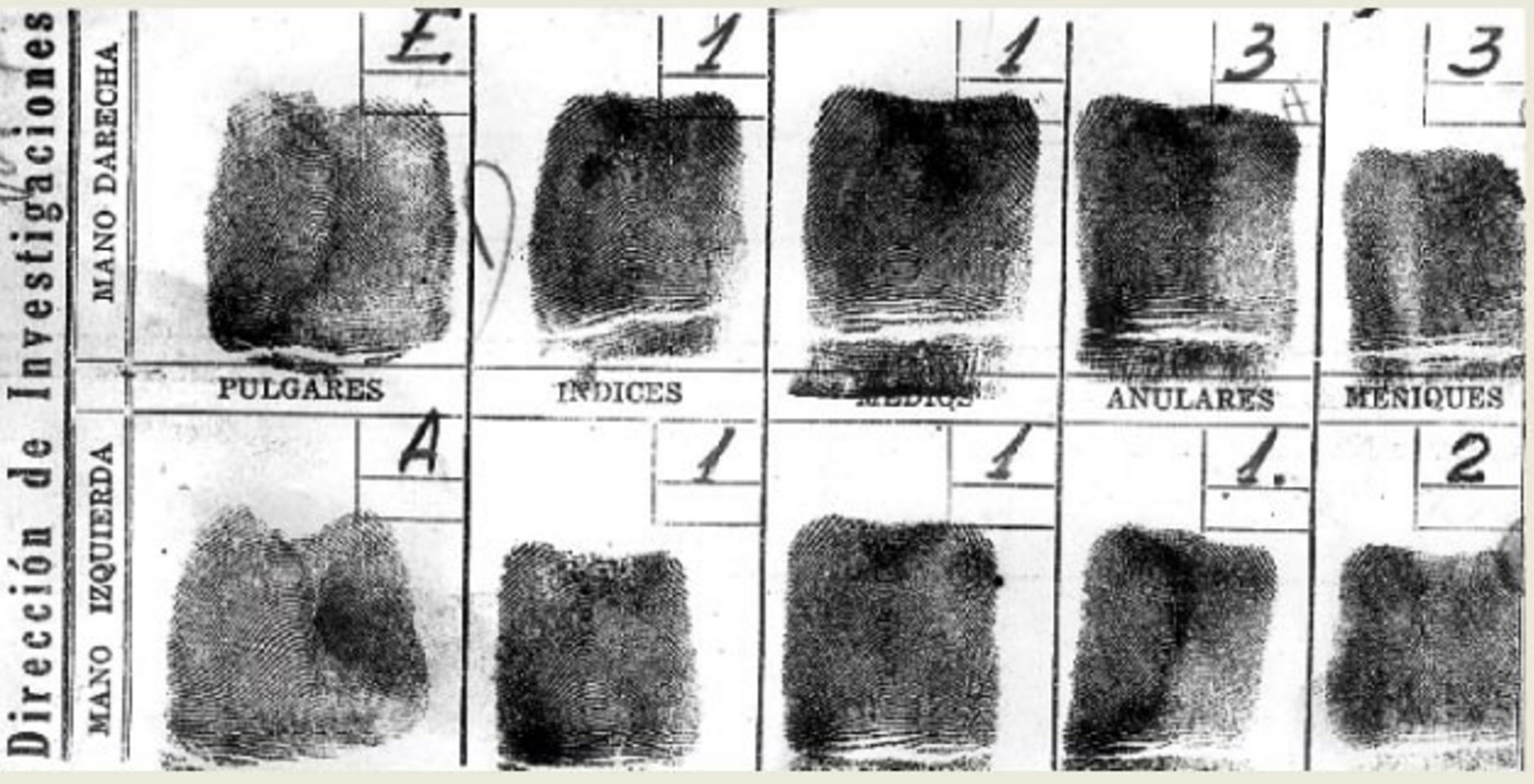
•
Right hand [thumb to pinky]: radial loop - arch - tented arch - (ulnar) central pocket loop - ulnar loop
Left hand [thumb to pinky]: arch - radial loop - ulnar loop - ulnar loop - ulnar loop

For statistical purposes - the following famous persons do NOT have arches:
Clyde Barrow (American outlaw & robber - Bonnie & Clyde)
Ted Bundy (American serial killer)
Al Capone (American gangster)
Walt Disney (founder of Disney)
Adolf Eichman (Nazi)
Albert Einstein (German theoretical physicist)
Dwight David Eisenhouwer (US President 1953-1961)
Ernest Miller Hemingway (American author & journalist)
John Lennon (UK musician - Beatles)
Martin Luther King (American Baptist minister)
Richard Nixon (former US president)
Barack Obama senior (father of the US president)
Lee Harvey Oswald (assumed sniper who killed former US president John F. Kennedy)
Elvis Presley (American singer)
James Earl Ray (convicted of the assassination of civil rights and anti-war activist Martin Luther King, Jr.)
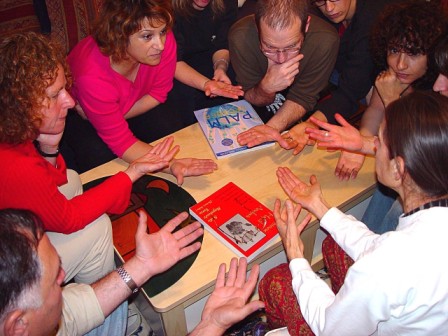
Some of the hand reading experts in the Global Hand Reader Network have presented interesting contributions on the 'arch' fingerprint inside their book(s):

Hand Analyst Ed Campbell writes in his book 'Encyclopedia of Palmistry' (page 114):
"Simple arch (Earth Element, the Digger): According may palmists, this refers to a simple type of personality, which follows the fundamental survival motives of security and protection and exhibits shyness, practicality, and perhaps inhibition, though I have seen some very outward and successful persons with this sign predominating."

Hand analyst Magda van Dijk writes in 'Standaardwerk Univerele Handleeskunde' (page 165):
TRANSLATED FROM DUTCH LANGUAGE: "Arch pattern - This indicates a practical doer who has a common sense, does not turn back to the things and knows a task to perform well. This type will, with great effort, organize concrete tasks properly and identify with his actions. It is someone that can be trusted, but that can itself be suspicious and reluctant. He tends to express his feelings in a practical manner."

Palmist Johnny Fincham writes in 'Palmistry: From Apprentice to Pro in Twenty-Four Hours' (page 65+66):
"Simple arch - The bedrock, binding and holding, giving the quality of being deep, fixed, materialistic, stubborn, loyal, repressed, prizing equality and faithfulness. A sense of inhibition, unpretentiousness. One that is physical, persistent and practical."

Chirologist Jennifer Hirsch writes in 'God Given Glyphs' (page 98):
"The arch fingerprint has a sturdy look and might evoke images of reliability, simplicity, dependability and steadiness. The earth nurtures us, supports us and provides our structure. Looking at this simple, hill-like pattern, earthy traits about it's bearer, such as them being uncomplicated, hard working, realistic, capable, peace loving, 'earthy' and many others, could come in mind. People with even one arch would bring a calming influence to a crisis situation."
![]() FINGERPRINTS INDEX:
FINGERPRINTS INDEX:
INTRO: Fingerprints & Hand Diagnostics
• HISTORY of Fingerprints
• CLASSIFICATION of Fingerprints
• SEXE DIFFERENCES & Fingerprints
• ETHNIC DIFFERENCES & Fingerprints
• DISEASES & Fingerprints
• Fingerprints & BEHAVIOR!
• FINGERPRINT DISTRIBUTIONS on the 5 Fingers
• WORLD MAP of Fingerprints
• 10 Facts about radial loop fingerprints
• 10 Facts about arch fingerprints
• MORE NEWS about Fingerprints
• Dermatoglyphics Multiple Intelligence Test